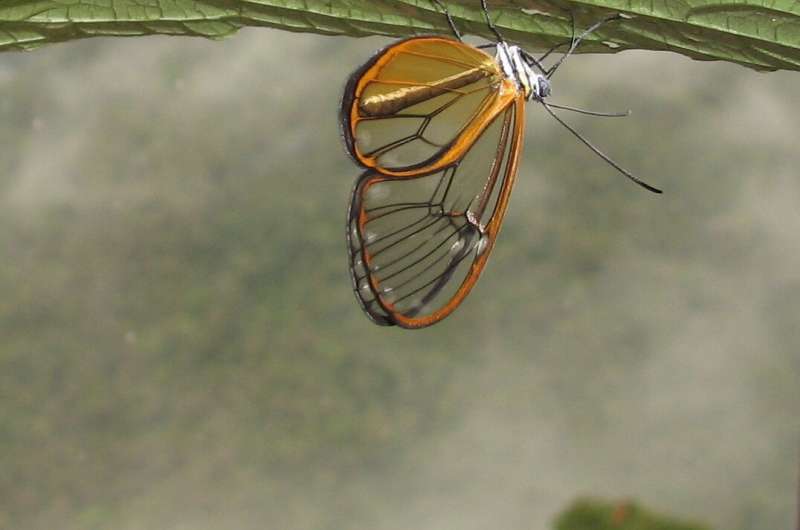The Andean butterfly Hypomenitis enigma has a wing pattern combining colored elements and transparent areas. This pattern is a warning signal indicating to predators that the butterfly is distasteful. In this species, transparency arises from the reduction of scales, and is enhanced by the presence of tiny structures called nanopillars on the wing. Credit: Marianne Elias (CC BY-NC 4.0)
Transparent wing patches may do more than allow butterflies and moths to hide—they may also warn predators to leave them alone, suggests a study published today in eLife.
The findings shed new light on how some butterflies and moths that have partially transparent wings have evolved to mimic other species that already had this feature. They also provide new details on the tiny structures that allow light to pass through the wing.
Despite their delicate look, butterflies and moths have numerous defenses. They may use camouflage or transparent patches on their wings to escape a predator's notice, or they may use bright, contrasting colors to warn predators that they are toxic or otherwise unpalatable. These warning color patterns are so effective at warding off predators that other butterfly and moth species—even ones without toxic defenses—evolve to mimic them. While transparency usually allows butterflies and moths to escape predators by blending into their surroundings, some species have evolved both transparent patches and vivid warning colors.
"We set out to explore the structural and optical features of transparent patches in various species that also have warning colourations," says first author Charline Pinna, a Ph.D. student at Muséum national d'Histoire naturelle, Sorbonne Université, Paris, France. "By doing so, we hoped to determine how butterflies and moths evolved these defenses and how bird predators perceive them."
Pinna and her colleagues used a method called spectrophotometry to measure the transmission of light through the transparent patches on 62 species. They then used computer modeling to determine how similar the transparent patches would look to bird predators. They found that the transparent patches on the wings of the insects and their mimics appear very similar to birds, which suggests that the look-a-like species are undergoing a process called convergent evolution, when two species independently evolve a similar trait that is beneficial to their survival. While it was already known that colored patches on the wings of butterfly and moth mimics undergo convergent evolution, this study shows for the first time that this process extends to transparent wing patches.
Next, the team used digital microscopy and scanning electron microscopy to examine the tiny structures on the transparent patches. This was to help them understand how transparency is produced on the insects' wings, which are normally covered entirely by colored scales. The team suspected that the coverage of the wing by these scales should be reduced somehow to allow for the transparent patches.
Their work showed that a large array of scale modifications can create transparent wing patches and that these modifications control how light passes through the wing. The team also uncovered an unexpected diversity of tiny structures that cover the wing membrane, and which enhance transparency considerably by limiting the reflection of light. These nanostructures are sometimes similar in look-a-like butterfly and moth species, even when they are distantly related, supporting the idea that the species have undergone convergent evolution for those structures, too.
The authors also suggest that transparency may come at a cost for species that live largely in the humid tropics, because transparent patches are likely less water resistant than opaque wing patches. Another potential cost is to the insects' thermoregulation. Butterflies and moths typically regulate their body temperature with their wings, and pigmented scales are important for them to accumulate heat to the point where, in many species, populations living in cooler areas are usually darker and less able to control their body heat. However, the fact that transparency has repeatedly evolved in butterflies and moths suggests the benefits likely outweigh these costs.
"Our findings show how species with transparent wing patches may benefit from double protection from predators," concludes Marianne Elias, a senior researcher at Muséum national d'Histoire naturelle, Sorbonne Université, and a co-senior author of the study alongside Doris Gomez. "At a distance, transparent patches may make butterflies and moths harder for predators to see, but up close their warning color patterns may also alert predators to leave them alone."
More information: Charline Sophie Pinna et al, Mimicry can drive convergence in structural and light transmission features of transparent wings in Lepidoptera, eLife (2021). DOI: 10.7554/eLife.69080
Journal information: eLife
Provided by eLife
























